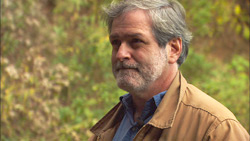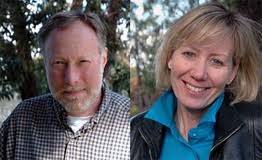Aldo Leopold never cared for fame and fortune. His classic, A Sand County Almanac (1949), has sold millions, but he’s largely unknown today outside a small circle of dedicated environmentalists. “Aldo Who?” a quiz show contestant might well ask.
For decades, family members, friends, and followers have kept Leopold’s flame burning. Now, scientists, teachers, and activists want to make him as well known as his book and as respected a figure as Henry David Thoreau, the author of Walden, John Muir, the founder of the Sierra Club, and Rachel Carson whose feisty polemic, Silent Spring, helped create the Environmental Protection Agency.
2013 might be the Leopold moment for our time and just in “the nick of time,” to borrow Thoreau’s phrase, now that unprecedented climate change is here with a bang not a whimper. A snazzy documentary about Leopold entitled Green Fire, completed two years ago, is about to reach large audiences with a nationwide airing on on PBS in April. The Library of America has just published a collection of Leopold’s best work, edited by Curt Meine, who headlines the three-day Geography of Hope Conference, March 15-17, in Point Reyes Station that’s all about the author of A Sand County Almanac.
Leopold’s home and the subject of the book was Sauk County, Wisconsin. But there’s arguably no more fit setting for this conference than West Marin with its rich agricultural history, organic farmers, and ferocious battles over trees, water, and, most recently, the oyster, the lowly mollusk that made Point Reyes legendary and that divided friends and families when the federal government last fall ruled that Drake’s Bay Oyster Company should be shuttered. With the wounds still unhealed, Robert Hass, a former U.S. Poet Laureate and a long-time resident of Marin, hopes that the conference will create a calm atmosphere to talk about the oyster wars.
“Oysters and the environment are an inescapable topic,” he said. “This year’s conference is more relevant to Marin than any other we’ve ever had.”
The rallying cry for the 2013 conference – “Igniting the Green Fire: Finding Hope in Leopold’s Land Ethic” – grew organically from previous gatherings about farming and water. The first conference, in 2009, focused on the “geography of hope,” a phrase coined by Pulitzer Prize winning novelist, Wallace Stegner, who died in 1993.

In the crowded field of Leopold studies, nobody knows more about Leopold than his official biographer, Curt Meine. A modest mid-westerner like Leopold, Meine gives credit to all the players on the Leopold team and insists that Leopold’s legacy ought to be written and rewritten by everyone in a community, whether it’s Point Reyes or his own in the Driftless area of Wisconsin. Like Leopold and like Stegner, Meine expresses hope about the environment, though he doesn’t lapse into glib optimism.
“Every landscape is pregnant with hope and despair,” he said. “No landscape is so bleak that it’s hopeless. Even in the most despairing environments, something positive can be done.”
Almost everyone who writes about Leopold has an epiphany. Meine’s took place in 1982 in the University of Wisconsin library. An eager graduate student, he opened a box with Leopold’s papers and held them in his hand as though they were the Dead Sea Scrolls.
“That particular box contained the papers that were in his desk when he died,” Meine said. “Some were typed, some handwritten, some the barest of fragments.”
Three decades later, he looks back at the evolution of his career from fledgling student to venerable scholar. He also sees, perhaps clearer than ever before, the growth of Leopold’s thinking about the wilderness – that quintessential American landscape.
“As a young man the wilderness was his hunting ground,” Meine said. “Later, he prized it as an historical site because so much of the American past was enacted there. In the 1930s, with the Dust Bowl, he developed an ecological sense of the wild. In the 1940s, he recognized its importance as a living laboratory for scientists, and, near the end of his life, it became a spiritual place. On his deathbed, he was a staunch advocate for wild lands and at the same time a defender of farms and farming.”
The film, The Green Fire, shows Leopold wearing all his many colorful hats. There’s a stunning image of him, for example, in 1909 in the Arizona territory. A recent graduate of the Yale School of Forestry, he recreated himself as a cowboy with a six-gun and a Stetson, employed by the fledgling National Forest Service. Leopold’s friend, Rube Pritchard, boasted in a letter to his mother that he’d rather work in an American forest than be crowned King of England. Leopold added modestly, “I’m beginning to agree.”
Co-produced by Ann and Steve Dunsky, both of whom work in Vallejo for the U.S. Forest Service, Green Fire offers Leopold’s own words as read by Marin County’s inimitable Peter Coyote, whose deep, resonant voice is instantly recognizable.
“I never prepared to read from Leopold,” Coyote tells me. “I’ve done voiceovers for hundreds of films and I always work like an improvisational jazz saxophonist.”
Still, Coyote couldn’t have been better prepared. A longtime, heart-felt fan of Leopold’s work, he grew up on a farm, and later learned about nature and spirituality from California Indians, Zen Buddhists, and from his buddy, Gary Snyder, who taught him that “the wild has his own dictates.”

“Coyote is amazing,” Ann Dunsky tells me. “He read perfectly from A Sand County Almanac on the first take.” She and her husband, Steve, come to Leopold’s work from opposite directions. He’s an Easterner; she’s a Westerner. He grew up thinking hunters were evil; she came from a family of hunters. He’s a dogged researcher; she’s a creative filmmaker. These days, they share a love of Leopold, whom they see as a life-long moderate who avoided extremes and whose work can bridge clashing communities and opposing schools of thought.
“When I first read A Sand County Almanac as a teenager, I saw it as the ruminations of an old man with quaint stories,” said Steve Dunsky. “ I went back to it in my 40s and found it a complex work that examines the big picture and sees human beings as a part of the natural world. His ‘land ethic’ links all of us and every species on the Earth.”
Professor Kathleen Moore, a philosopher and ethicist at Oregon State University, thinks that everyone who graduates from college ought to have read Leopold’s A Sand County Almanac and understood it.
“If students are too busy to read it, they ought to see Green Fire,” she said.
When undergraduates and colleagues want to know her favorite passage in Leopold’s classic she turns instantly to the section entitled “The Outlook” and reads:

“A thing is right when it tends to preserve the integrity, stability, and beauty of the biotic community. It is wrong when it tends otherwise.”
A fiery teacher, impassioned moralist, and compassionate writer, she doesn’t think the sky is falling, but she insists that the oceans are rising fast and furious and argues that if humans don’t act wisely, quickly, “we’ll soon be caught between hell and high water.” Leopold’s ethical values can help, she said, “if humans stop thinking of themselves as solitary beings and recognize they’re part of a system and have an impact on it.”
She adds, “I’m going to the Geography of Hope Conference, to present my own ideas, listen to others, and help create a model for rational discourse that others around the country might use.”
Wendell Gilgert calls himself a “Leopoldian.”. In high school in 1964, his English teacher told him to go to the library, find a book, and read it. A Sand County Almanac changed his life. For decades he worked with the USDA Natural Resources Conservation Service. In 2011 he became the Working Landscapes Program Director at PRBO Conservation Science, a Marin County non-profit. These days, he goes into fields and farms, talks the farmer talk and walks the rancher walk.
“I don’t tell anyone what to do or how to improve what they’re already doing,” he said. “I suggest tools they might use. I learned that from Leopold.”
Gilgert hopes farmers and ranchers will be effective stewards of the land, protect watersheds, enhance soils, and guard wildlife habitat. Mike and Sally Gale in Chileno Valley, and Loren Poncia in Tomales, operate sustainable ranches that might be emulated, Gilgert said.
The most surprising take on Leopold comes, not surprisingly, from poet Robert Hass, a guiding light of the Geography of Hope Conference who put Marin’s geography on the literary map of America in volumes of poetry such as The Apple Trees of Oleama. Hass compared Leopold to T.S. Eliot, another mid-westerner, born a year after Leopold, and the author of The Waste Land, the quintessential modernist poem that offers a geography of despair in lines such as “Here is no water but only rock.” On first glance, Leopold and Eliot seem like polar opposites, but Hass argues that A Sand County Almanac, like The Waste Land, is a modernist work in that it’s made up of “patches and fragments.”
Furthermore, he believes that The Waste Land is an ecological poem and that, despite Eliot’s sense of alienation and despair, was written “out of a hunger for wholeness.”
If anyone at the Geography of Hope conference can fuse seeming opposites and bring together apparent foes, it’s surely Hass. No one followed Marin’s oyster wars as sensitively as he, and no one hungers more for the wholeness of the community than he. Hopeful and fearless, he’s prepared to talk about the links between Wallace Stegner and Aldo Leopold and eager, too, to persuade the volatile members of Marin’s divided community to sit down with one another and share ideas.
“I hope that there’s time for poetry, too,” he said. “We’ve got to have poetry to have a geography of hope.”
Jonah Raskin is a contributor to Bay Nature.





